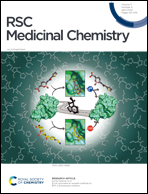Unveiling the active isomer of cycloalanopine, a cyclic opine from Lactobacillus rhamnosus LS8, through synthesis and analog production†
Abstract
Opines are widely distributed natural products formed by the reductive condensation of amino acids with α-keto acids or carbonyls of carbohydrates. They have important biological roles in bacteria, higher plants, fungi, invertebrates and mammals, including humans. An unusual cyclic opine of undefined stereochemistry, cycloalanopine, was previously isolated from Lactobacillus rhamnosus LS8 and reported to have antimicrobial activity against both Gram-negative and Gram-positive bacteria. In this work, we report a three-step strategy to synthetically access pure isomers of this cyclic compound and analogs thereof. In the key step, acyclic bis-hydrazides can be oxidized with (diacetoxyiodo) benzene to corresponding cyclic N,N′-diacylhydrazides. The three cycloalanopine isomers, along with several analogs, were synthesized and tested against a panel of Gram-positive and Gram-negative bacteria. We identified the active isomer as the meso compound: (4R,6S)-4,6-dimethyl-1,2,5-triazepan-3,7-dione. Additionally, a glycine derivative, (R)-4-methyl-1,2,5-triazepan-3,7-dione, was ascertained to be more potent. This compound was active against both Gram-positive and Gram-negative organisms with the strongest potency against Escherichia coli and Acinetobacter baumannii, an opportunistic pathogen found in hospital-derived infections.



 Please wait while we load your content...
Please wait while we load your content...